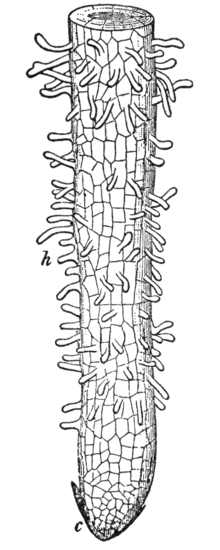Root hair: Difference between revisions
ClueBot NG (talk | contribs) m Reverting possible vandalism by 95.131.110.109 to version by 81.97.140.242. False positive? Report it. Thanks, ClueBot NG. (600736) (Bot) |
|||
| Line 7: | Line 7: | ||
==Formation== |
==Formation== |
||
poopy face |
|||
Root hairs are usually an outgrowth of a single epidermal cell {{Citation needed|date=January 2010}}. Root hair cells vary between 5 and 17 [[micrometre]]s in diameter, and 80 to 1,500 micrometres in length (Dittmar, cited in Esau, 1965). |
|||
==Importance== |
==Importance== |
||
Revision as of 14:15, 20 September 2011

A root hair, the rhizoid of a vascular plant, is a tubular outgrowth of a trichoblast, a hair-forming cell on the epidermis of a plant root. That is, root hairs are lateral extensions of a single cell and only rarely branched, thus invisible to the naked eye. They are found only in the region of maturation of the root. Just prior to the root hair cell development, there is a point of elevated phosphorylase activity.
Function
The function of the root hairs is to collect large amounts of water and nutrients in the soil and control how much is needed, this is mainly so it can be transferred around the plant to help it do other things like photosynthesis and others.
Formation
poopy face
Importance
Root hairs form an important surface over which plants absorb most of their water and nutrients. They are also directly involved in the formation of root nodules in legume plants
They have a large surface area, relative to the other cells, that helps them absorb water using osmosis and minerals more efficiently.
Survival
Root hair cells can survive for 2 to 3 weeks and then die off. At the same time new root hair cells are continually being formed at the tip of the root. This way, the root hair coverage stays the same. When a new root hair cell grows, it excretes a poison so that the other cells in close proximity to it are unable to grow one of these hairs. This ensures equal and efficient distribution of the actual hairs on these cells.
It is, therefore, understandable that re-potting must be done with care, because the root hair cells are pulled off for the most part. This is why planting-out leaves the plant withered for some time.
See also
References
- Esau, K. 1965. Plant Anatomy, 2nd Edition. John Wiley & Sons. 767 pp.
